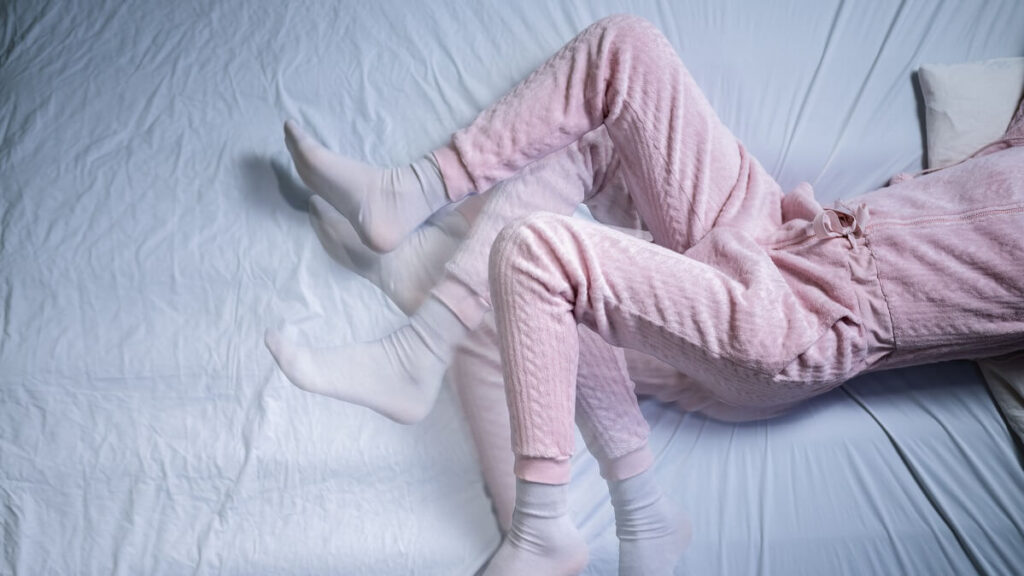Restless legs syndrome (RLS) is a neurological disorder that triggers unpleasant sensations in the legs, such as itching, prickling, pulling, or crawling. These sensations can range from mildly irritating to downright painful and create an overwhelming urge to move the legs.
The most serious concern for people with RLS is that it interferes with sleep, causing daytime sleepiness and fatigue. RLS and sleep deprivation can put you at risk for other health problems, including depression if not treated.
Understanding restless legs syndrome
RLS is not just a minor annoyance; it’s a genuine medical condition that affects approximately five to 10 per cent of adults, with women being more susceptible than men. While it can occur at any age, the most severe symptoms often present in older adults. While some may experience symptoms sporadically, others find RLS to be a persistent and disruptive presence in their lives.
The most severe cases can make even the simplest activities, like watching a movie or enduring a long flight, a challenge.
According to the International Classification of Sleep Disorders, the words and phrases most commonly used by people with RLS to describe their feelings are:
- “Twitchy”
- “Uncomfortable”
- “Restless”
- “Need to stretch”
- “Urge to move”
- “Legs want to move on their own.”
Restless legs and insomnia
One of the most challenging aspects of RLS is its impact on sleep. The urge to move often intensifies when you’re lying down, making it difficult to fall asleep or stay asleep. In fact, a study found that a staggering 88 per cent of individuals with RLS reported sleep-related issues. This can lead to fatigue, daytime sleepiness, and even contribute to depression, anxiety, heart disease, and obesity due to chronic sleep deprivation.
Moreover, many people with RLS also experience periodic limb movement disorder (PLMD), which involves involuntary limb movements during sleep. While PLMD doesn’t cause the uncomfortable sensations associated with RLS, it can further disrupt sleep, leading to a vicious cycle of restlessness and fatigue.
Causes of restless legs syndrome
The exact cause of RLS is still somewhat of a mystery. In some cases, it’s linked to other medical conditions such as kidney disease, iron deficiency, neuropathy, multiple sclerosis, or Parkinson’s disease. Pregnancy can also trigger temporary RLS symptoms, particularly in the third trimester, though they usually subside after delivery.
There’s also a genetic component to consider. Many people with RLS have a family member with the condition, suggesting hereditary factors at play. While researchers have identified some genetic markers associated with RLS, there’s still much to learn about the condition’s origins.
Triggers and risk factors
Certain triggers can exacerbate RLS symptoms, including prolonged periods of sitting or resting.
Substances that can worsen the condition include:
- alcohol
- caffeine
- nicotine
- certain medications, such as those for nausea, colds, and allergies.
Managing restless legs syndrome
If you suspect you have RLS, it’s essential to consult with a healthcare professional for a proper diagnosis and treatment plan. Management strategies for RLS can range from lifestyle changes to medication, depending on the severity of the symptoms.
Treatment options
While there is no cure for RLS, there are several strategies to manage and alleviate symptoms:
Lifestyle changes: reduce or eliminate caffeine, alcohol, and tobacco.
Prioritising sleep: maintain a regular sleep schedule and ensure you get enough sleep each night.
Exercise: because physical inactivity often triggers RLS symptoms, exercise may be helpful. A research study found that RLS patients showed a 39 per cent reduction in symptom severity after six weeks of engaging in an exercise program compared to an 8 per cent symptom reduction in patients who did not exercise.
Medications: various drugs, including dopaminergic agents, benzodiazepines, opioids, and anticonvulsants, can be prescribed to manage symptoms. However, these medications come with potential side effects and risks, so it’s essential to work closely with your doctor to find the most suitable treatment.
Pneumatic pressure therapy: devices that apply pressure to the legs can improve blood flow and reduce symptoms.
Massage and hot baths: while scientific evidence is limited, many people find relief from RLS symptoms through leg massages and hot baths.
Diet: ensuring adequate intake of essential vitamins and nutrients, particularly iron, can be beneficial. Pairing iron-rich foods with vitamin C sources can enhance iron absorption.
Have you ever suffered with restless legs? Have you found a way to relieve the discomfort? Let us know in the comments section below.
Also read: Why too many Aussies are not getting enough sleep
Disclaimer: This article contains general information about health issues and is not advice. For health advice, consult your medical practitioner.

